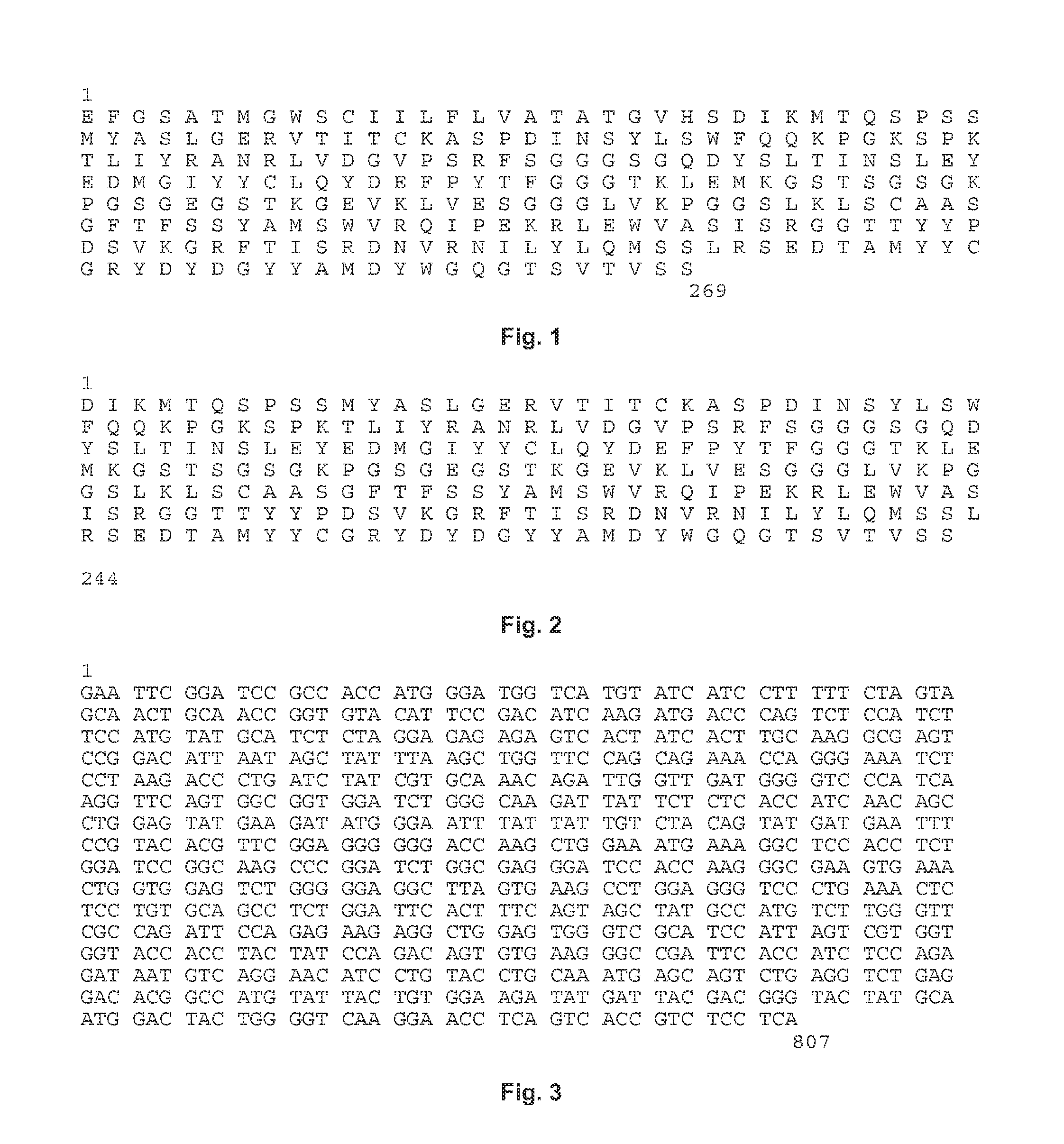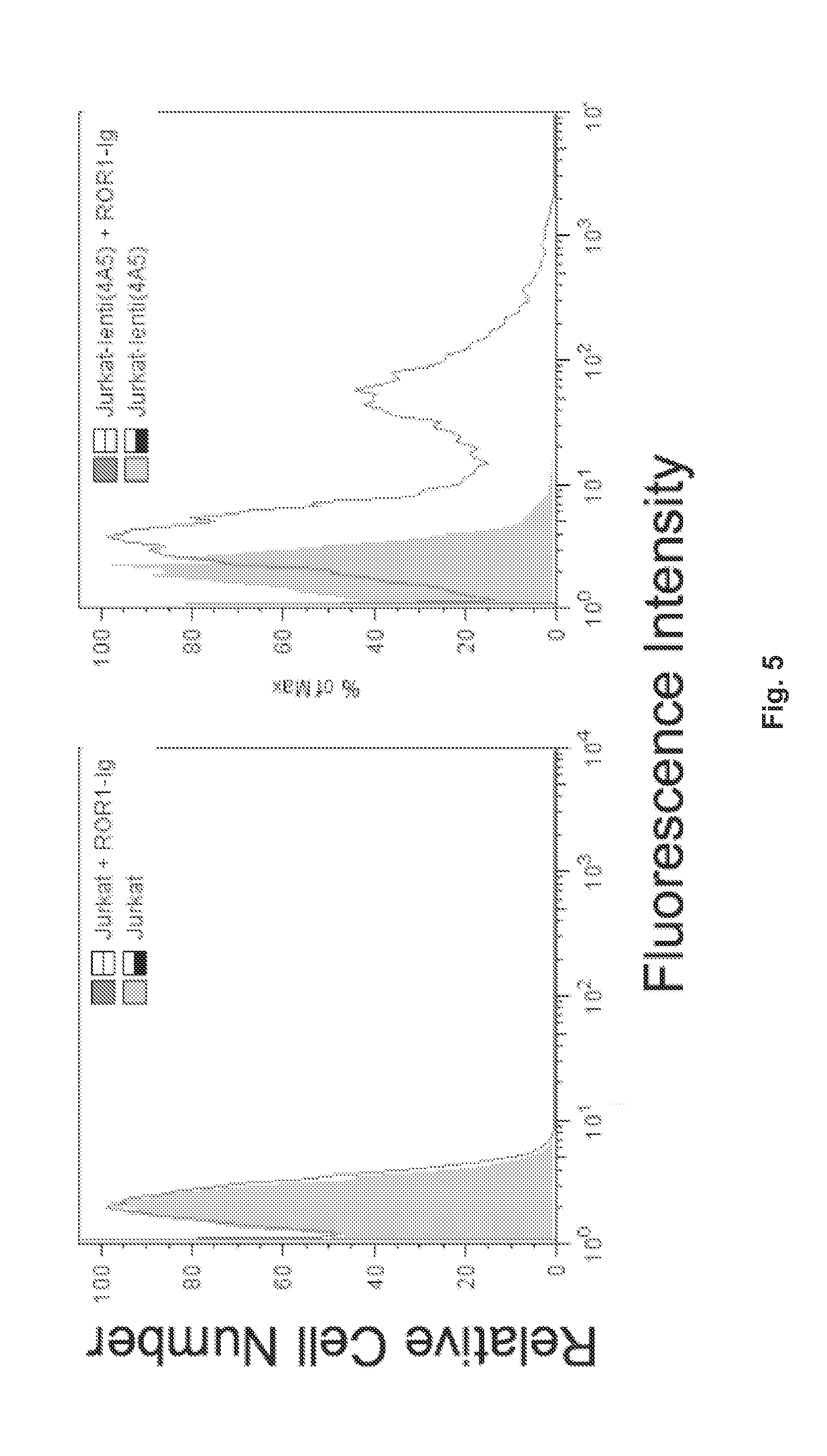Receptor Tyrosine Kinase-Like Orphan Receptor 1 (ROR1) Single Chain FV Antibody Fragment Conjugates and Methods of Use Thereof
a technology of receptor tyrosine kinase and receptor 1 is applied in the field of single chain fv fragments of tumor-associated antigen binding antibodies, which can solve the problems of cancer patients being unable to mount an effective immune response against existing or developing tumors, cll cells are particularly poor at antigen presentation, and affect the immune response of laa-targeted vaccines
- Summary
- Abstract
- Description
- Claims
- Application Information
AI Technical Summary
Benefits of technology
Problems solved by technology
Method used
Image
Examples
example 1
Generation of an scFv Construct
[0120]This example illustrates generation of an scFv antibody conjugate of the present invention.
[0121]The scFV having SEQ ID NO: 3 was inserted upstream of the sequence encoding an IgG4 CH domain, the transmembrane domain of CD28 and cytoplasmic domain of the zeta chain for the T-cell receptor (CD247) to generate a chimeric antigen receptor (CAR).
[0122]The construct was inserted into a lenti-virus vector for transduction of T cells (Jurkat). The T cells were examined for their capacity to bind a soluble ROR1 protein (ROR1-Ig). Cell-bound ROR1-Ig could be detected by staining the cells with an anti-Ig antibody that was labeled with a fluorescence dye, phycoerythrin (PE). This allowed monitoring of changes in fluorescence of the T cells caused by binding the ROR1 protein using flow cytometry.
[0123]The results are shown in FIG. 5.
example 2
scFV Targeting of ROR1 Expression by Lymphocytic B Cells
[0124]Dual parameter flow cytometry was done in a FACSCalibur instrument (BD Biosciences; Immunocytometry Systems) using an anti-human IgG that reacted with cell bound scFV of the invention (as shown in SEQ.ID.No: 3), but not the cells used in these experiments. CHO cells (which do not express ROR1) and EW36, a human B-cell lymphoma cell line (National Cancer Institute) were stained with culture supernatants of cells transfected to express pCDNA 3.1 (Invitrogen) CH2CH3 stable scFV (FIG. 6).
[0125]In particular, approximately 5×105 cells were incubated for 20 minutes with the scFV, the cells were then washed and then incubated with an Alexa-488-conjugated goat anti-human-IgG antibody that does not react with EW36 cells in the absence of the cell-bound scFV. Propidium iodide was added to stain dead cells, which could then be excluded from the analysis. Following incubation with the culture supernatants, the cells were washed prior...
PUM
| Property | Measurement | Unit |
|---|---|---|
| Fraction | aaaaa | aaaaa |
| Fraction | aaaaa | aaaaa |
| Fraction | aaaaa | aaaaa |
Abstract
Description
Claims
Application Information
 Login to View More
Login to View More - R&D
- Intellectual Property
- Life Sciences
- Materials
- Tech Scout
- Unparalleled Data Quality
- Higher Quality Content
- 60% Fewer Hallucinations
Browse by: Latest US Patents, China's latest patents, Technical Efficacy Thesaurus, Application Domain, Technology Topic, Popular Technical Reports.
© 2025 PatSnap. All rights reserved.Legal|Privacy policy|Modern Slavery Act Transparency Statement|Sitemap|About US| Contact US: help@patsnap.com



